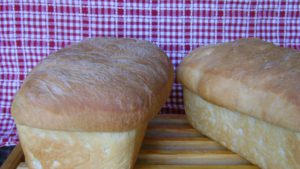Homemade sourdough equivalent

Fresh out of the oven after baking, this recipe yields two scrumptious loaves of sour cream bread. Let it cool, and have a slice with butter. Life doesn’t get better than this.
If you are in the mood for a loaf of bread with a tangy taste similar to sourdough, and not quite as heavy, or as ‘sour,’ try this sour cream loaf at home. It also takes a lot less time, and is less complex than making sourdough bread. We have, on occasion, mixed a bit of plain yogurt or buttermilk as part of the 500 mL of sour cream. It turns out terrific each time.
The loaf rises to a very light texture. Give it enough time in each rising. Make sour cream bread before a party, to fill the house with the aroma of a bakery, and stir your guests’ imagination and appetite for this exotic, light loaf with its exquisitely different taste.
Start at least three to four hours before serving. This recipe will make two loaves of bread.
Ingredients
| Ingredient | Quantity |
|---|---|
| Active dry yeast (or quick-rise instant yeast) | 1 pkg |
| Granulated sugar | 15 mL (1 tsp) |
| Warm water (40°C to 45°C) | 60 mL (¼ cup) |
| Sour cream (room temperature) | 500 mL ( 1 tub) |
| Egg (room temperature) | 1 |
| Baking soda | 4 mL (¼ tsp) |
| Salt | Small dash (to taste) |
| Sugar and/or sugar substitute | 30 mL ( 2 tbsp) |
| Flour (suggested blend) | 675 mL (2½ cups) unbleached 250 mL (1 cup) whole wheat 250 mL (1 cup) bread flour |
Preparation
- For traditional yeast: Combine yeast, sugar and warm (not hot) water in a medium size (half-litre) container, and allow the yeast to proof (rise), about 10 to 15 minutes. We normally put the container of yeast in a layer of medium warm water in the sink to rise;
- When the yeast has at least doubled in size, and has a frothy top, add it to the liquid ingredients;
- Mix the dry ingredients: Combine the flour mixture with a dash of salt, sugar, baking soda and if you are using instant yeast, one package of quick-rise instant yeast in a mixing bowl (or electric mixer bowl) and stir together;
- Mix the liquid ingredients: In a container of at least 500 mL (2 cups minimum) capacity, add the sour cream, and egg. If you are using traditional yeast, add it to the liquid mixture after it has risen. Using a hand mixer, gently beat the liquid ingredients together into a smooth texture. Suggested variation: try half-and-half buttermilk and sour cream;
- Add the liquid mixture slowly to the dry ingredients while mixing well. If you are using an electric mixer, slowly pour the liquid mixture into the solid ingredients while the mixer combines them evenly;
- The dough should be moist and a little sticky when it comes out of the mixing bowl. Turn out onto a floured board;
- Knead the dough for several minutes. It should feel soft and spongy;
- Butter a large mixing bowl, and shape the dough into a ball. Placing the dough into the mixing bowl. Cover with cling wrap and put it into a moist and warm area to allow the dough to rise. We use the kitchen sink, with a layer of very warm water at the bottom, and covered with the kneading board. Allow the dough to double in bulk;
- Punch the dough down, turn it out onto the floured kneading board and knead for a few minutes. Divide the dough into two equal parts;
- Butter two standard 9 x 5 x 3 inch baking pans (ours are glass), and fit the dough into the pans. Return the the warm and moist-air place (covered kitchen sink with a layer of warm water in our case) and allow the loaves to rise in the baking pans;
- Pre-heat the oven to 220°C (425°F). Bake for 10 minutes. Lower the oven temperature to 175°C (350°F), and bake another 25 minutes. The loaves should sound hollow when tapped on the top crust. After baking, turn out on a wire rack, and allow the loaves to cool;
- Slice and enjoy. The bread can be refrigerated or frozen to extend or preserve freshness, and then re-warmed briefly in an oven before serving.



I had to mind the cats and go to the Legislature during that cruise. I am looking forward to enjoying…